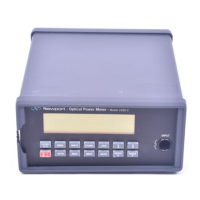21
<SRQ> Service Request
The 1830-C generates an <SRQ> to tell the GPIB controller that a serial poll
is needed. Any device on the GPIB bus may assert the <SRQ> line. Bit 6
(decimal 64) will be high in the serial poll byte returned from a device
requesting service. To determine if a device has generated an SRQ, an
“AND” operation could be performed on the Status Byte :
IF ((serial poll) AND 64) = 64 THEN ⇒ device is requesting service,
where serial poll is the integer returned from a GPIB serial poll.
Whitespace
Optional between commands and between parameters. Whitespace is any
character with a binary value less than or equal to an ASCII space character
( except the <NL> character ).
Numerical types
Numerical parameters are passed and returned as the actual ASCII charac-
ters in the string representation of the number. The 1830-C accepts nu-
meric values in decimal format only.
RS-232C Command Termination
Commands and queries sent to the 1830-C through the RS-232C port should
be terminated with a <LF>.
All responses sent by the 1830-C are terminated with a <LF>.
GPIB Command Termination
Commands and queries sent to the 1830-C through the GPIB must be
terminated with a <NL> <EOI> (<NL> is equivalent to an <LF>).
All responses sent by the 1830-C are terminated with a <NL> <EOI>.
5.3 Entering Remote Computer Interface Mode
When a command or query is received by the GPIB or RS-232C interface
ports, the 1830-C automatically goes into the remote interface mode. The
REM annunciator on the 1830-C display will light up to indicate that the
1830-C is in remote interface mode.
When in remote mode, the 1830-C can be issued a “L1” command. The LLO
annunciator on the 1830-C display will also light up to indicate that the
1830-C is in the local-lockout mode. This mode disables the 1830-C front
panel keypad from affecting system operation. Locking out the front panel
keys is useful in applications where the user does not want inadvertent key
presses to affect his application setup. “L0” command disables the local-
lockout feature. The local-lockout mode can also be disabled by powering-
up the meter again, or by pressing the “RESET” button located at the back
of the meter.

